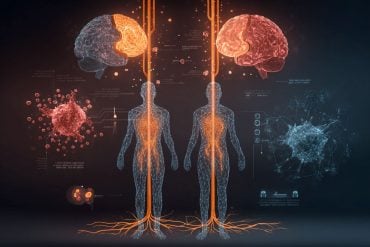Summary: Japanese researchers have uncovered how the astringent “bite” of cocoa flavanols can activate the brain—even though little of the compound enters the bloodstream. In mice, the sensation of astringency triggered sensory nerves that stimulated neurotransmitters linked to motivation, alertness, and memory.
The brain’s noradrenaline network lit up, producing stress-like but beneficial physiological responses similar to those from exercise. The findings suggest that flavanols’ sensory impact—not just their absorption—may help explain how foods like chocolate and berries sharpen focus and boost brain health.
Key Facts
- Sensory Signaling: Flavanols’ astringent taste directly stimulates sensory nerves, activating the brain’s noradrenaline network.
- Exercise-Like Response: Flavanols induced mild stress responses that enhanced attention, learning, and memory in mice.
- New Nutrition Insight: Findings support the concept of “sensory nutrition,” where taste-driven signals influence brain and body function.
Source: Shibaura Institute of Technology
Astringency is a dry, puckering, rough, or sandpapery sensation in the mouth caused by plant-derived polyphenols. Polyphenols, including flavanols, are well known for risk reduction in cardiovascular diseases. Flavanols, found abundantly in cocoa, red wine, and berries, are associated with improved memory and cognition, as well as protection against neuronal damage.
Despite these benefits, flavanols have poor bioavailability—the fraction that actually enters the bloodstream after ingestion. This has left an important knowledge gap: how can flavanols influence brain function and the nervous system when so little of them is absorbed?

In response to this challenge, a research team led by Dr. Yasuyuki Fujii and Professor Naomi Osakabe from Shibaura Institute of Technology, Japan, investigated how flavanols affect the nervous system through sensory stimulation.
The study, made available online on September 11, 2025, and published in Volume 11 of the journal Current Research in Food Science, tested the hypothesis that the astringent taste of flavanols may act as a direct signal to the brain.
“Flavanols exhibit an astringent taste. We hypothesized that this taste serves as a stimulus, transmitting signals directly to the central nervous system (comprising the brain and spinal cord).
“As a result, it is thought that flavanol stimulation is transmitted via sensory nerves to activate the brain, subsequently inducing physiological responses in the periphery through the sympathetic nervous system” explains Dr. Fujii.
The researchers conducted experiments in 10-week-old mice, administering flavanols orally at doses of 25 mg/kg or 50 mg/kg body weight, while control mice received only distilled water. Behavioral tests showed that flavanol-fed mice exhibited greater motor activity, exploratory behavior, and improved learning and memory compared to controls. Flavanols enhanced neurotransmitter activity across several brain regions.
Dopamine and its precursor levodopa, norepinephrine and its metabolite normetanephrine were elevated in the locus coeruleus–noradrenaline network immediately after the administration. These chemicals regulate motivation, attention, stress response, and arousal.
Furthermore, enzymes critical for noradrenaline synthesis (tyrosine hydroxylase and dopamine-β-hydroxylase) and transport (vesicular monoamine transporter 2) were upregulated, strengthening the signaling capacity of the noradrenergic system.
In addition, biochemical analysis revealed higher urinary levels of catecholamines—hormones released during stress—as well as increased activity in the hypothalamic paraventricular nucleus (PVN), a brain region central to stress regulation. Flavanol administration also boosted the expression of c-Fos (a key transcription factor) and corticotropin-releasing hormone in the PVN.
Taken together, these results demonstrate that flavanol intake can trigger wide-ranging physiological responses resembling those induced by exercise—functioning as a moderate stressor that activates the central nervous system and enhances attention, arousal, and memory.
“Stress responses elicited by flavanols in this study are similar to those elicited by physical exercise. Thus, moderate intake of flavanols, despite their poor bioavailability, can improve the health and quality of life,” remarks Dr. Fujii.
These findings have potential implications in the field of sensory nutrition. In particular, next-generation foods can be developed based on the sensory properties, physiological effects, and palatability of foods.
Funding: This work was supported by JSPS KAKENHI (Grant Number 23H02166).
Key Questions Answered:
A: Their astringent taste acts as a sensory stimulus, directly activating brain pathways.
A: Neurotransmitters like dopamine and norepinephrine surge, boosting alertness and motivation.
A: It reveals a new mechanism—taste-based neural activation—that could inspire smarter, brain-targeted food design.
About this neuroscience research news
Author: Kohei Tsuchiya
Source: Shibaura Institute of Technology
Contact: Kohei Tsuchiya – Shibaura Institute of Technology
Image: The image is credited to Neuroscience News
Original Research: Open access.
“Astringent flavanol fires the locus-noradrenergic system, regulating neurobehavior and autonomic nerves” by Yasuyuki Fujii et al. Current Research in Food Science
Abstract
Astringent flavanol fires the locus-noradrenergic system, regulating neurobehavior and autonomic nerves
Astringency is a characteristic exhibited by only a limited number of polyphenolic compounds which show high electrochemical activity and are susceptible to oxidation at neutral pH conditions like the oral cavity and small intestine.
Large-scale intervention studies have demonstrated that the astringent flavanol (FLs) can restore hippocampal-dependent memory. However, due to the low bioavailability of FLs, the mechanism of action remains unclear.
In this study, we aimed to elucidate the mechanism by which FLs acts on the nervous system through the gastrointestinal tract. Following a single gavage dose of FLs to mice, spontaneous motor activity in the open field and improved short-term memory in the novel object test were enhanced.
Concurrently, activation of stress response systems, such as the sympathetic–adrenal–medullary axis (increased urinary catecholamines) and the hypothalamic–pituitary–adrenal axis (increased corticotropin-releasing hormone mRNA in paraventricular nucleus) was also observed.
By the Mass imaging and in situ hybridization analyses, high-intensity noradrenaline (NA) originating from the locus coeruleus (LC) was revealed in the hypothalamus and brainstem immediately after FLs administration.
These changes of NA have been suggested as the cause of enhanced memory, arousal and sympathetic activity. Furthermore, increased NA in the nucleus accumbens was observed as a response to visceral sensations induced by oral FLs administration.
The present findings highlight how astringent stimulants FLs may activate brain function and the autonomic nervous system via gastrointestinal stimulation, causing physiological changes.
These insights suggest that the sensory properties of food are important for maintaining homeostasis and promoting human health.






